

Home/Active Page
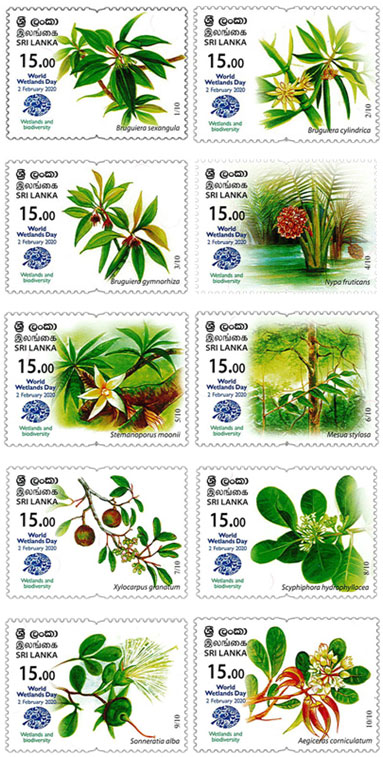
The philatelic bureau of the Postal Department has issued 10 stamps and souvenir sheets, worth Rs. 15.00 each on February 03, 2020, to mark the World Wetlands day, which falls on February 02. These stamps depict mangroves and other plants that grow in Sri Lankan wetlands.
| Date of Issue | 3rd of February 2020 |
| Denomination | Rs.15.00 x 10 |
| Catalogue No: |
01.Bruguierasexangula–Malkadol - CSL 2354 02.Bruguiera cylindrical –Malkadol - CSL 2355 03.Bruguieragymnorrhiza – Malkadol- CSL 2356 04.Nipa Palm – Ginpol - CSL 2357 05.Stemanoporusmoonii – Horawel -CSL 2358 06.Mesuastylosa–Suwanda -CSL 2359 07.Xylocarpusgranatum – Muttikadol CSL -2360 08.Scyphiphorahydrophyllacea - KaluKadol- CSL 2361 09.Sonneratia alba - Yak/Gal Kirala - CSL 2362 10.Aegicerascorniculatum - Heenkadol/ EwariKadolCSL 2363 |
| Stamp Designer | P.Isuru Chathuranga | Stamp Size: | 30mm x 41mm |
| Sheet Composition: | 20 stamps per sheet |
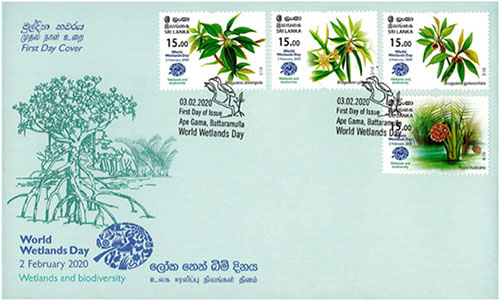
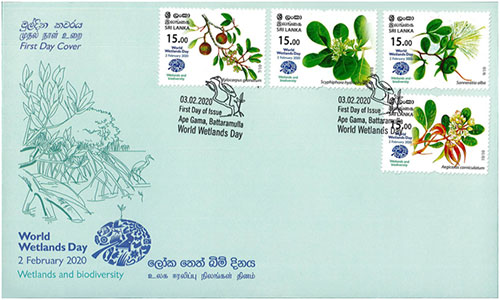
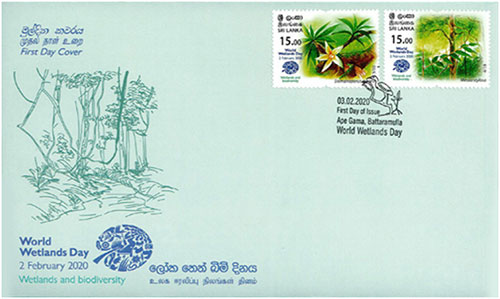
|
|
|
|
|
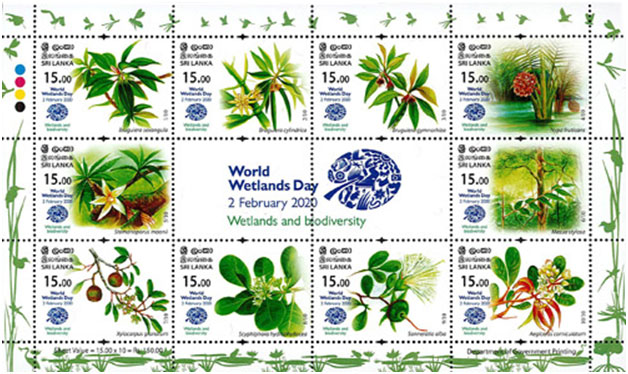
According to the internationally accepted definition, wetlands are areas where water covers the soil, or is present either at or near the surface of the soil all year or for varying periods of time during the year, including during the growing season.
According to the Ramsar Convention on Wetlands, which uses a broad definition of wetlands, these areas includes all lakes and rivers, underground aquifers, swamps and marshes, wet grasslands, peat-lands, oases, estuaries, deltas and tidal flats, mangroves and other coastal areas, coral reefs, and all human-made sites such as fish ponds, rice paddies, reservoirs and salt pans. Since human civilization emerged close to wetlands, we consider these areas as the birth place of civilization.
Wetlands cover 6% of the world's land mass and almost all countries have such areas. Governments around the world have declared 21 million kilometers as wetlands as per the Ramsar Convention on Wetlands. World Wetlands Day is celebrated on February 02 t remind everyone the vital importance of wetlands for our survival.
There are 62 wetlands of national importance in Sri Lanka and six of them have been named wetlands of international importance by the Ramsar Convention. They are Bundala, Anawilundawa, Madu Ganga, Wankalei, Kumana and Wilpattu.
The role played by the wetlands in assuring a sustainable drinking water supply, providing land and water for agriculture, producing hydro electricity, controlling floods and for fisheries and tourism industry is of vital importance. Moreover since wetlands are rich in biodiversity, they are open labs Among the stamps are representations of Suwanda and Horawel, two plants that are point endemic to Sri Lanka. The Walawwatta, Waturana swamp forest, Damparandugoda, Bulathsinhala Divisional Secretariat area, Kalutara District in Western Province is the only place in the world where one can find these plants. Point endemic plants are grown only in a particular area. Waturana swamp forest, that is spread across 15 acres is also considered Sri Lanka's only swamp forest.
The Waturana swamp forest is situated in a private land owned by a company. On 2009 Waturana swamp forest was declared a protected area by a gazette. The Waturana swamp forest, situated on the left bank of the Batapotha Canal, which is a branch Kalu River, is flooded for an extended period from the water that seeps in during the rainy season.
Mangroves are a group of trees and shrubs that live in the coastal intertidal zone. With their roots submerged in water, mangrove trees thrive in hot, muddy, salty conditions that would quickly kill most plants. Unsurprisingly, plats that grow in other parts of the island do not grow in these ecosystems. Mangroves have adopted various mechanisms that ensure that they survive in these hostile environments.
According to the IUCN's Red Book, there are 21 endemic mangrove species in Sri Lanka and out of these eight are depicted in the stamps that are issued on February 03.
Bruguierasexangula is a member of the Rhizophoraceae family. The plant is known in Sri Lanka as Malkadol. The tree usually grows up to 15 meters. Upriver orange mangrove grows as a single-stemmed tree or multi-stemmed shrub. It has short buttresses at the base of the trunk, and knee-like air-breathing roots, or pneumatophores. Thus the plant is similar to Bruguiearagymnorhiza. Its leaves are smooth, glossy green and are shaped elliptic to elliptic-oblong. They are also smaller than Bruguiearagymnorhiza. The leaves are arranged opposite one another and most of the time the leaves reach a size of 12cm (8-15cm) long and 4cm (3-6cm) in width. Although it is sometimes mistaken Bruguieragymnorrhiza, it has smaller, thinner leaves and the flower petal tips are blunt without hairy tassels.
Bruguierasexangula's green, cigar-shaped viviparous propagule grows from within the calyx and is 5–12 cm long and 1–2 cm wide.The timber of the plant is heavy, hard and strong and is used as poles as well as for firewood and charcoal. Since the plants have flowers in most months, it also helps bee keeping.
This is a member of the Rhizophoraceae family. It is commonly known as Malkadol in Sri Lanka. It is s a small tree that grows between 5 to 7 meters tall but often grows as a bush. One unique feature is that the seed does not detach itself from the flower stalk but germinates where it is
Leaves are eye-shaped (10-12 cm long) stiff leathery glossy and are arranged opposite one another. Stipules pale yellow or greenish. The flowers are in small bunches of 2-5 in the axils of the leaves. They have 8 long green sepals and 8 smaller, greenish-white petals with several little bristles on the tip. The flowers are pollinated by insects and release a cloud of pollen when probed at the base by the insect's mouth. Bruguiearacylindrica is viviparous, the condition whereby the embryo (the young plant within the seed) grows first to break through the seed coat then out of the fruit wall while still attached to the parent plant. The shoot is thinner than shoots of other viviparous trees. The end of the radicle, the part of a plant embryo that develops into the primary root, is hook shaped.
This plant, which is seen in several areas in the intermediate zone is rarely seen in the wet zone. However one can find these plants in Negombo, which is in the wet zone. The spread is limited in Sri Lanka and is considered a threatened species according to the national red data book. However it is not a threatened species in other parts of the world. This can be seen in 8 out of 14 districts in Sri Lanka where mangroves can be found. Bruguiera cylindrical can be found in 18 out of 112 areas where mangroves grow around the world. This plant is commonly seen in Asian mangrove ecosystems. The timber of the plant is often used as firewood and charcoal. Since the plants have flowers in most months, it also helps bee keeping. In Negombo this plant is used in the fishing industry, especially in prawn farming.
Bruguieragymnorrhiza Mangrove is a member of the Rhizophoraceae family. It is commonly known as Malkadol in Sri Lanka. This is a small tree that grows up to 10 meters high. They also show a difference in height based on environmental factors. It has knee roots. which emerge as a root loop from the underground root system and allow the exchange of gases in oxygen-poor sediments.
The knee roots of an adult Bruguieragymnorhiza extend in a radius of approximately 10 meters around the trunk and can reach a height of up to 60cm. Each underground horizontally growing root develops several knee roots at regular intervals.
No other Mangrove species of the Bruguiera family develops as large leaves as the Bruguieragymnorhiza. The leaves are generally opposite and have an elliptic shape, the upper side is smooth and dark green the bottom is waxy and light green. Occasionally three or four leaves are formed simultaneously. The Oriental Mangrove develops leaves with a size of up to 25cm but generally between 12 to 20cm and about 3 to 9cm in width. The two stipules of each leaf are reddish and the stem is greenish to reddish. The colors of the blossoms vary from light orange to dark pink and dark red. Brugruieragymnorhiza always develops single axillary flowers. Numerous axillary Flowers with a size between 3 to 5cm can be found at each end of the branches of the tree. One flower has 9 to 14 orange, notched and hairy petals, 9 to 14 pink to red, fused sepals and 9 to 14 pairs of stamens. The propagule of a Bruguieragymnorhiza is its fruit. It grows within the calyx tube and is slightly grooved. The wood of Bruguieragymnorhiza has very high density and therefore very heavy, which made it very attractive as timber for the use of saltwater and foundation pilings, house posts, flooring, cabinetwork and furniture. Since flowers bloom for the most part of the year; it also helps with bee keeping. It is also used to build enclaves for certain types of fish. In 2012 National Red List; Bruguieragymnorhiza was identified as a vulnerable species. Bruguieragymnorhiza can be found in 11 out of the 14 districts where mangroves grow. It can also be found in 47 out of 112 areas where mangroves grow.
It is the only mangrove species that belong to the Arecaceae family. In Sri Lanka this is called Ginpol. It is also the only plant in the Nypa genus. They can be seen in some areas in wet and intermediate zones of Sri Lanka. They can be seen in large clusters in Kahangamodara, MadampaOya, Madu ganga, Kalu ganga, Bantara river and Gin Ganga.
Nypafruticans grows in less salinated water. They can be found in the upstream estuarine zone in low, mid, and high intertidal regions and forms extensive belts along brackish to tidal freshwater creeks and rivers. The large fronds are pinnate (feather-like) and usually 3 to 6 (sometimes up to 10) meters long, arising from the base of the plant. Leaflets number up to 120 per leaf, are 60-130 cm long, with a shiny green upper and powdery lower surface. The petiole (leaf stalk) is smooth, shiny and 1-2 m long with a bulbous base enclosing the stem. Leaf bases are below ground, although they are sometimes exposed by erosion. The yellow inflorescences are on long, sturdy stalks arising from the base of the plant. The female inflorescence is a densely packed, spherical head of flowers. The male inflorescence is a club-shaped spike of closely arranged flowers emerging from lateral stalks below the female inflorescence. The large spherical fruiting body is 30-45 cm in diameter. Individual fruits (carpels) are egg-shaped, angular, fibrous, 10-15 cm long, 5-8 cm wide and dark brown. Each fruit holds one egg-shaped seed. Propagules are crypto-viviparous The nipa palm has a trunk that grows beneath the ground (acaulescent), and only the leaves and flower stalk grow upwards above the surface. Thus, it is an unusual tree, and the leaves can extend up to 9 m (30 ft) in height. The flowers are a globular inflorescence of female flowers at the tip with catkin-like red or yellow male flowers on the lower branches. The flower yields a woody nut, these arranged in a cluster compressed into a ball up to 25 cm across on a single stalk. The ripe nuts separate from the ball and are floated away on the tide, occasionally germinating while still water-borne.
In the 2012 National Red List; Nypafruticans was identified as an endangered species. It is also protected by the Flora and Fauna Protection Ordinance. Nypafruticans can be found 29 out of 112 areas where mangroves grow in the world.
Stemanoporusmoonii on average grows up to 4 to 5 meters in height, usually as an un-branched woody stem. It is a plant of the Dipterocarpaceae family. A unique feature is a mop of long, lance-shaped leaves are at the apex of the stems. On average a leaf is about 45 cm long and about 8 cm in width. The tender leaves are reddish and droop down along the stem. The small flowers are white in colour and the small fruit is globular, and about 3 cm in diameter. This plant grows very slowly.
This is an endemic species found only in the Walawwawatta-Waturana swamp in Bulathsinghala,in the Kalutara District. Even there, Stemanoporusmoonii is spread in a very small area. The National Red List of Sri lanka declares it a critically endangered species. It is also protected by the Flora and Fauna Protection Ordinance. The Waturana swamp forest is situated in a private land owned by a company. On 2009 Waturana swamp forest was declared a protected area by a gazette (No 1598/21 on 24 April 2009. The Waturana swamp forest, situated on the left bank of the Batapotha Canal, which is a branch Kalu River, is flooded for an extended period from the water that seeps in during the rainy season.
Mesuastylosa is a species of flowering plant in the Calophyllaceae family which is found only in Sri Lanka. It grows up between 10 - 15 meters and has long thing leaves.
This is an endemic species found only in the Walawwawatta-Waturana swamp in Bulathsinghala,in the Kalutara District. Even there, Stemanoporusmoonii is spread in a very small area. The National Red List of Sri Lanka declares it a critically endangered species. It is also protected by the Flora and Fauna Protection Ordinance. The Waturana swamp forest is situated in a private land owned by a company. On 2009 Waturana swamp forest was declared a protected area by a gazette (No 1598/21 on 24 April 2009. The Waturana swamp forest, situated on the left bank of the Batapotha Canal, which is a branch Kalu River, is flooded for an extended period from the water that seeps in during the rainy season.
This is the only mangrove of Rubiaceae family found in Sri Lanka. It is known in Sri Lanka as Muttikadol. A tree can grow up to 12-15 meters in height. It grows in the higher intertidal zone and is found in estuaries and lining the banks of creeks. Bark is smooth and reddish or orange in color. Often the bark is flaking off in patches, revealing greenish new bark. Trunk base of older trees often enlarged with well-developed buttresses forming narrow ribbon-like undulations extending away from the trunk. The wood is hard and durable and in some countries are used for boat-building, construction and making furniture. However in Sri Lanka large enough trees to harvest timber have not been found.
The Xylocarpusgranatum is not extensively seen in Sri Lanka. In 2012 National Red List; Xylocarpusgranatum was identified as a endangered species. Bruguieragymnorhiza can be found in only 5 out of the 14 districts where mangroves grow. It can also be found in 36 out of 112 areas where mangroves grow. Although mangroves in general are under threat from coastal development, from harvesting, and global warming and the consequent rise in sea levels; Xylocarpusgranatum is a common species of mangrove with a very wide range. It is probably not declining at a sufficient fast rate to be included in any threatened category. For these reasons, the International Union for Conservation of Nature has listed it as being of "least concern".
The leaves are pinnate and arranged spirally on the twigs; they have two to four pairs of leaflets and are pale green when young and darken with age. The inflorescence grows in a short panicle in the axil of a leaf or at the end of the shoot. The individual flowers are 8 mm wide, with parts in fours, and are white or pinkish-yellow. They are followed by large, spherical, woody capsules, 4 to 12 cm in diameter, which split open to reveal up to a dozen seeds.
Scyphiphorahydrophyllacea is the only mangrove of the Meliaceae family that is found in Sri Lanka. This grows as a bush and can group up to 3 meters in height. This is a rare tree in the mangrove ecosystem in Sri Lanka and can only be seen in mangrove clusters in the dry zone. They have roots with pneumatophores (knee-roots). The above ground root system of Xylocarpusgranatum is often absent in young plants but older plants often display butresses, which cause enlargement of the trunk base diameter, and which extend into partially above-ground ribbon like roots. Leaves are light green in color, with a rounded apex, and on average 10 cm long and 4 to 6 cm wide. Petiole of the leaf is short and corky. The bark is smooth, unfissured and thin, displaying a pattern of light-brown to orange patches, caused by peeling of the bark. The flowers of Xylocarpusgranatum are very small and are white in color. They occur in dense clusters at the leaf angles, with 4 white lobes tinged pink.
This mangrove species are seen in some parts of Kalpitiya, Vanathawilluwa and Pooneryn. In 2007 National Red List; Scyphiphorahydrophyllacea was identified as a highly endangered species. In 2012 National Red List; Scyphiphorahydrophyllacea was identified as an endangered species. It can be found in only 2 out of the 14 districts where mangroves grow. It can also be found in 19 out of 112 areas where mangroves grow.
Sonneratia alba is a tree that belongs to the Lythraceae family. This plant is known in Sri Lanka as Yak/Gal Kirala. These threes are located in a limited number of areas in Sri Lanka. They are concentrate in mangrove clusters at Negombo, Chilaw and Mannar. Although these have the potential to grow up to 40 meters in height; such large trees have not been found in Sri Lanka. They grow in highly salinated soil and the tree is surrounded by thick, blunt pneumatophores (vertical roots arising from shallow, horizontal roots.) Leaves nearly circular or spoon-shaped (5-12.5cm) tapering at the base, thick and leathery. Young leaves are pale green with faint tinge of pink at the leaf 'tip'. The leaves are arranged opposite one another.
Flowers are large, around 10cm in diameter with 6 petals narrow white often inconspicuous, and many long white stamens that are pink at the base, forming a powder-puff shape. Stiff cup-shaped calyx with sepals broadly triangular and reddish on the inside. The flowers are pollinated by fruit-eating bats. Thus the flowers bloom at night and can't be seen during the day. The pneumatophores are made into floats for fishing nets.
In 2012 National Red List; Sonneratia alba was identified as an endangered species. It can be found in only 3 out of the 14 districts where mangroves grow. It can also be found in 33 out of 112 areas where mangroves grow. However IUCN has categorized them as least threatened category.
Aegicerascorniculatum is the only mangrove that belongs to the Myrsinaceae family that is found in Sri Lanka. They are known in Sri Lanka as HeenKadol/ EwariKadol. They are found in areas that has soil with high salinity. Aegicerascorniculatum grows as a shrub or small tree up to 5 meters high. Aegicerascorniculatum are rarely found in magraove cluster in the wet zone. These are especially seen in Rekawa, Kahangamodara, Chilaw, Puttalam and Kalpitiya.
The leaves are oval and about and they have glands for secreting salt. The flowers are small, white and arranged in bunches. The propagules are up to 5 cm long, pencil thick, slightly curved and have a pointed tip. The end of the fruit that is attached to the tree has a spiral patterned cap. The fruits are green, ripening to red.
In 2012 National Red List; Aegicerascorniculatum was identified as a least threatened species. It can be found in 8 out of the 14 districts where mangroves grow. It can also be found in 20 out of 112 areas where mangroves grow. However IUCN has categorized them as least threatened category.
All rights reserved. All right to identify the Department of Posts as the Author and designer of this Bulleting has been asserted in accordance with the Copyright, Design and Patents Act 1988.No part to this publication may be reproduced, stored in or introduced into a retrieval system, or transmitted in any form or by and means (electronic, mechanical, photocopying, recording or otherwise) without the prior permission from the publisher. Any person who does and unauthorized act in relation to this publication may be liable to criminal prosecution and civil claims for damages.)